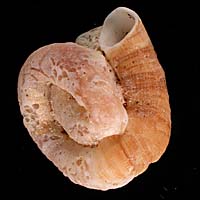|
< Previous family introduction |
|
|||||
 |
Family Vermetidae Worm shells
|
|||||
|
The vermetid worm shells have irregularly coiled or contorted shells which are attached to hard surfaces by their early whorls. Although they do not appear to be so from the shape of the shell, they are typical gastropod molluscs, with a normal head with tentacles, and a foot, which bears an operculum in some species. Shells bear many similarities to those of the Siliquariidae, but the animals are substantially different anatomically. Vermetids are sedentary animals, and feed by capturing plankton from the water column in one or two ways. In the first method, plankton is filtered from the water that passes over the gills, in the manner of bivalves or the other family of worm shells, the Siliquariidae. The other method is to extrude mucous threads that are washed about in the water to form a net in which plankton is trapped. The net is drawn back in by the radula and the plankton transported to the mouth for consumption. Remarkably for sedentary animals, vermetids are of separate sexes. Males release packages of sperm into the water, some of which are captured in the feeding web of females and eventually fertilize the female's eggs. Fertilized eggs are brooded in the mantle cavity of the female, and crawling or free-swimming larvae are released. In NSW vermetids occur uncommonly on rocky shores intertidally and subtidally. They are not well studied and the species are poorly defined. The two species detailed here have long been recognized, but there are several other small or deep-water species from NSW in the Australian Museum collection. Information available on distributions is confused, due to lack of knowledge of the species. Family Reference There is no consolidated reference to the species, either in Australia or the Indo-West Pacific, but the species from Rottnest Island, WA, were detailed by Hughes. Some at least of these species also occur in NSW.
Both named species found in NSW are detailed here. Two species listed in Iredale & McMichael's 1962 work, A Reference List of the Marine Mollusca of NSW, are now considered to be tubes of polychaete worms of the family Serpulidae (Ponder, pers. comm). These are:
Identification Notes Shells of the family Siliquariidae are similar to vermetids, but most have a slit or series of holes along the tube. Some polychaete worms construct regularly or irregularly coiled shells which have been mistaken for vermetids, but these differ in construction from the three-layered molluscan shell. |